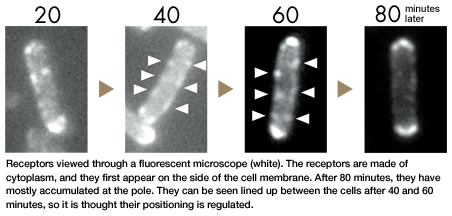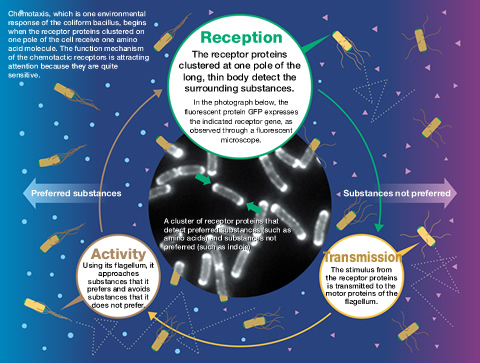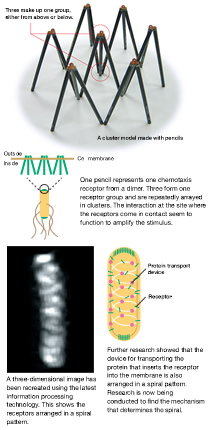Research
A sensor that functions like the nose at the pole of the coliform bacillus
The coliform bacillus uses its flagellum to move to a more desirable environment. Its receptors are sensors that detect that which it prefers and that which it does not prefer. These receptors are clustered on one pole of its body. They respond to the slightest of changes and convey stimuli to the flagellum. This nose-like mechanism is important for understanding the functions of molecules that support the activities of living creatures.
The coliform bacillus lives by responding appropriately to an environment with drastic changes, such as in temperature or nutritional conditions. Chemotaxis, the behavior in which it avoids substances it does not prefer and approaches that which it prefers, is an excellent means to study the mechanism of environmental response. All the proteins involved with the conveyance of information for chemotaxis are understood. For example, the chemotaxis receptor is a responsive sensor that conveys to the cell the coupling with one amino acid molecule. One receptor becomes paired with the long, thin protein, and these cluster at one pole of the coliform bacillus. By becoming arrayed in a regulated cluster, their sensitivity improves. Only part of the receptor couples with the amino acid, because the response is derived from the interaction between all the clusters. It functions like an efficient nose.
The process in which the cluster is formed is also very interesting. The receptor, which is made with cytoplasm, at first looks as if it has been inserted in the intervals between the cell membranes. In fact, they are placed in a spiral shape and move along that course to the pole. The mechanism by which the movement starts has not yet been identified, but there are recent reports of different proteins placed in a spiral. The molecules are placed in suitable spots within the cell, which leads us to postulate the existence of a structure that becomes tissue. We want to make a good model for understanding the relationship between the function of molecules in the coliform bacillus and the movement of the solid (cell).

Received a doctorate in science from the University of Tokyo in 1990. He also was a doctoral fellow at Yale University in the U.S. He served as an assistant at the Nagoya University School of Science and later as an associate professor at their Graduate School of Science. In 2007, he was appointed a professor at Department of Frontier Bioscience, Faculty of Engineering, Hosei University.
- Dialogue:A space that living beings can inhabit is created
Toyo Ito / Keiko Nakamura - Research01:Discovering the principles by which form is created
Atsushi Mochizuki - Research02:A sensor that functions like the nose at the pole of the coliform bacillus
Ikuro Kawagishi - Scientist Library:From chromosome research to life inheritance science
Mitsuhiro Yanagida
|
|

